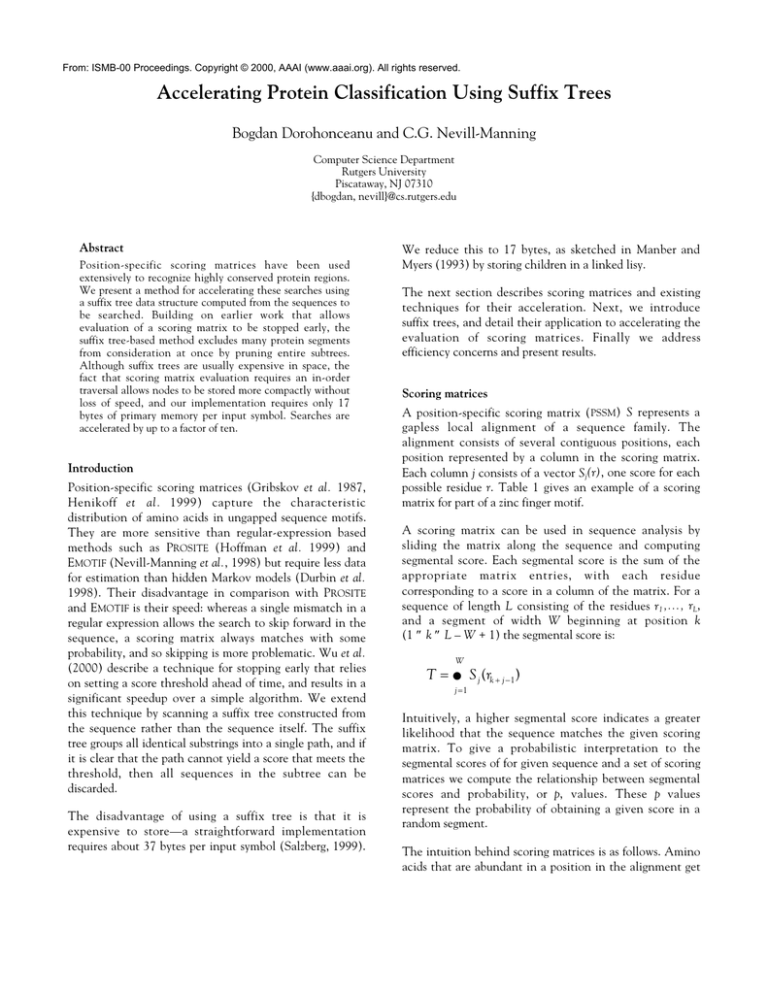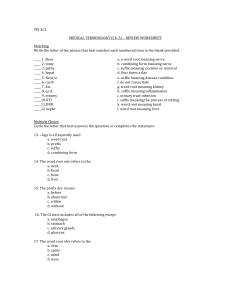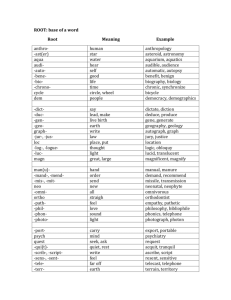
From: ISMB-00 Proceedings. Copyright © 2000, AAAI (www.aaai.org). All rights reserved.
Accelerating Protein Classification Using Suffix Trees
Bogdan Dorohonceanu and C.G. Nevill-Manning
Computer Science Department
Rutgers University
Piscataway, NJ 07310
{dbogdan, nevill}@cs.rutgers.edu
Abstract
Position-specific scoring matrices have been used
extensively to recognize highly conserved protein regions.
We present a method for accelerating these searches using
a suffix tree data structure computed from the sequences to
be searched. Building on earlier work that allows
evaluation of a scoring matrix to be stopped early, the
suffix tree-based method excludes many protein segments
from consideration at once by pruning entire subtrees.
Although suffix trees are usually expensive in space, the
fact that scoring matrix evaluation requires an in-order
traversal allows nodes to be stored more compactly without
loss of speed, and our implementation requires only 17
bytes of primary memory per input symbol. Searches are
accelerated by up to a factor of ten.
Introduction
Position-specific scoring matrices (Gribskov et al. 1987,
Henikoff et al. 1999) capture the characteristic
distribution of amino acids in ungapped sequence motifs.
They are more sensitive than regular-expression based
methods such as PROSITE (Hoffman et al. 1999) and
EMOTIF (Nevill-Manning et al., 1998) but require less data
for estimation than hidden Markov models (Durbin et al.
1998). Their disadvantage in comparison with PROSITE
and EMOTIF is their speed: whereas a single mismatch in a
regular expression allows the search to skip forward in the
sequence, a scoring matrix always matches with some
probability, and so skipping is more problematic. Wu et al.
(2000) describe a technique for stopping early that relies
on setting a score threshold ahead of time, and results in a
significant speedup over a simple algorithm. We extend
this technique by scanning a suffix tree constructed from
the sequence rather than the sequence itself. The suffix
tree groups all identical substrings into a single path, and if
it is clear that the path cannot yield a score that meets the
threshold, then all sequences in the subtree can be
discarded.
The disadvantage of using a suffix tree is that it is
expensive to store—a straightforward implementation
requires about 37 bytes per input symbol (Salzberg, 1999).
We reduce this to 17 bytes, as sketched in Manber and
Myers (1993) by storing children in a linked lisy.
The next section describes scoring matrices and existing
techniques for their acceleration. Next, we introduce
suffix trees, and detail their application to accelerating the
evaluation of scoring matrices. Finally we address
efficiency concerns and present results.
Scoring matrices
A position-specific scoring matrix (PSSM) S represents a
gapless local alignment of a sequence family. The
alignment consists of several contiguous positions, each
position represented by a column in the scoring matrix.
Each column j consists of a vector Sj(r), one score for each
possible residue r. Table 1 gives an example of a scoring
matrix for part of a zinc finger motif.
A scoring matrix can be used in sequence analysis by
sliding the matrix along the sequence and computing
segmental score. Each segmental score is the sum of the
appropriate matrix entries, with each residue
corresponding to a score in a column of the matrix. For a
sequence of length L consisting of the residues r1,…, rL,
and a segment of width W beginning at position k
(1 ≤ k ≤ L – W + 1) the segmental score is:
W
T = ∑ S j (rk + j − 1)
j =1
Intuitively, a higher segmental score indicates a greater
likelihood that the sequence matches the given scoring
matrix. To give a probabilistic interpretation to the
segmental scores of for given sequence and a set of scoring
matrices we compute the relationship between segmental
scores and probability, or p, values. These p values
represent the probability of obtaining a given score in a
random segment.
The intuition behind scoring matrices is as follows. Amino
acids that are abundant in a position in the alignment get
A
1
2
3
Y
max
-19 92 -45 -49 -30 -36 -38 -12 -41 -21 -22 -40 -46 -44 -44 -30 -25 16 -35 -34
C
D
E
F
G
92
2
9 -19 -33 -25
22
24
5 -17 17 22 -28 -15
-7 -23
K
L
M
N
P
-8 -27 -21 26 18
-7 -13
S
-9
T
V
W
thresholds
36
60
99
159
5
-14 -22 14 22 -28
181
6
-25 -34 -25 -16 -37 -30 -15 -36 45 -34 -26 -18 -35
9
10
9
-8 -26 15 -27 -20
-8 -25 -24 -19 -23 -22
-34 -27 -44 -43 60 -41
7 40 -16 -14
-7 43 16
-9 -14
-7 -27 -15
-4
R
-5 -25 -32 -26 -25 -18 13 22 -11 36
8
2 -25 -10 25 -23
Q
-29 99 -55 -61 -42 -45 -47 -31 -52 -34 -36 -49 -56 -55 -55 -38 -35 -29 -44 -46
7
-8 -29 -28
I
4
7
7
H
4 -15 -10
-7 -26
-3 31 -13
5 -23 -30 -24
22
-9 49 -25 -26 -33 -39 -31
49
230
-8 -19 -29 -21 11 -13 31 31 -31 -22
31
261
-8 -16 -38 -14 -17 -39 -51 -40 -36 -39 -35 -21
-6 -17 14 -20 -15 -10 -24 -11 12 15
-9 -24
-5 -26 -18
-6 -25 25 13 25
-1 56
56
317
9 -13 -16 20
40
357
-8 -21 -30 -24
43
400
Table 1 A position-specific scoring matrix and the intermediate thresholds used for early
stopping when the global threshold is 400
high scores, and those that are rare get low scores. Scores
are log-odds scores: log(fa,o/fa,e), where fa,o is the proportion
that amino acid a is observed in the position, and fa,e is the
proportion of amino acid a in nature (its expected
proportion). Multiplying odds scores for amino acids in a
particular segment of the protein of length m yields the
likelihood that this segment belongs to the same
distribution as the multiple alignment. Adding log-odds
scores is equivalent to multiplying odds scores, but it is
faster and is not susceptible to underflow or overflow. For
a more comprehensive treatment of PSSMs, see matrices
Gribskov et al. (1987) and Henikoff et al. (1999.)
Many implementations of PSSMs for protein function
prediction, such as BLIMPS apply the scoring matrix to
each segment of each protein in the input, sort the
segments by their scores, and present the top few hits. Wu
et al. propose setting a threshold for the score a priori, and
storing and presenting only those hits that score above the
threshold. This saves storage space for lower-scoring
segments, and eliminates sorting. They present a method
for computing an appropriate score for a particular
specificity, i.e. the score that a segment of random amino
acids would be likely to exceed with a probability p. The
probability p is chosen according to the size of the
database in order to minimize false positives but maintain
sensitivity.
The next optimization that Wu et al. introduce is stopping
a score computation early using a technique known as
lookahead scoring. Consider the matrix in Table 1 with a
threshold of 400. The last column shows that a sequence
must score at least 400 after the entry from the last row is
added to be considered a match. The maximum score that
can be achieved in the last position is 43, so the score by
the end of the 9th position must be at least 357 to be able
to make 400 by the 10th position. Similarly, the highest
score in the second-last position is 40, so the score must be
at least 317 in the eight position. These intermediate
thresholds can be calculated for all other positions in a
similar way. They are calculated ahead of time, and during
the evaluation of a particular protein segment, the
computation can be stopped early if the score fails to reach
the appropriate intermediate threshold. This is the scoring
matrix analog to skipping forward with a regular
expression: when it is clear that the overall threshold
cannot be reached for this segment, the rest of the
segment can be skipped. In the rather extreme case of
Table 1, the segment can be skipped if it does not begin
with V or C: they are the only residues that score at least 2
in the first position. Note that stopping is more likely to
occur as the global threshold is increased, or equivalently,
as the overall probability of match is decreased. Wu et al.
report that this optimization doubles the speed of scoring
for p = 10–20 and increases speed by a factor of five for
p = 10–40.
Suffix trees
A suffix tree is a compacted trie of suffixes in a string, i.e.
for every suffix of a string, there is a path in the
corresponding suffix tree from root to leaf labeled with
that string. Figure 1a shows a tree of suffixes for the string
abab$. This tree is compacted in the following way.
Wherever two edges beginning at the same node share a
prefix, a new edge and node are created, and the edge is
labeled with the shared prefix. The two original edges no
longer share a prefix. This operation is performed until no
two edges from the same node share a prefix. This
compacted tree is a suffix tree, and is shown in Figure 1b.
Suffix trees allow operations such as finding whether a
substring occurs in a string to be performed efficiently.
This query can be performed in time proportional to the
length of the substring by following the path from the root
of the suffix tree. If the path exists, the substring exists in
the string.
a
b
$
$
abab$
b$
bab$
Figure 1
trees
ab$
ab
ab$
b
$ ab$
$
(a) uncompacted and (b) compacted suffix
The cost of creating the suffix tree must be added to any
operations. A suffix tree can be inferred from a string of
length n in O(n) time (McCreight 1976, Ukkonen 1995).
In our experiments, the cost of creating the suffix tree is
negligible compared to the cost of evaluating the scoring
matrices. For a tutorial on suffix tree construction, see
Nelson (1996) or Gusfield (1997)
To find a high-scoring segment in a set of protein
sequences, we first form a suffix array from the sequences,
then do a depth-first traversal of the tree, calculating the
scores for the edge labels. Whenever the score at some
node in the tree reaches the threshold, all the substrings
represented by the leaves below that node must also reach
the threshold, and can be reported. More significantly,
whenever the score at some node falls below the
intermediate threshold, no substrings corresponding to
leaves in the subtree can reach the threshold, and the
entire substring can be ignored. This is the key to the
acceleration: many substrings can be discounted based on
looking at a single path. Figure 2 shows the two cases: a
subtree of matches and a subtree of non-matches.
We have to deal specially with the ends of the sequences,
and have investigated two approaches. The first approach
forms a suffix tree from the set of sequences, taking special
threshold can't
be reached
threshold
reached
no matches
all matches
Figure 2 Two accelerations that suffix trees provide: a
subtree where every leaf points to a matching segment,
and a subtree where every segment can be ignored
note of the ends of the sequences, and adding extra leaves
to the tree to specify where sequences end. The second
approach concatenates all the sequences, placing a special
end of sequence symbol (EOS) between them. This tree
includes suffixes that cross sequences, which are suffixes
are useless, but can be easily ignored. In order not to
introduce new special cases in the tree traversal algorithm,
we add EOS to the scoring matrix and give it a large
negative score in all positions. If the threshold is reached
in the suffix tree before encountering the EOS symbol,
then care must be taken in calculating the final score for
the resulting matches: when EOS is encountered, the
summation should finish. If, on the other hand EOS is
encountered before the threshold is reached, the large
negative score ensures that the sequence boundary is not
crossed, and that the subtree is pruned.
Compact suffix trees
A significant problem with suffix trees is their size in
primary memory. For an alphabet of size Σ, each node in
a suffix tree has at most Σ nodes. For concreteness, we
will assume that the alphabet consists of the natural amino
acids, so that Σ = 20. A straightforward implementation
would use a 20 element array of pointers for the children,
a pointer to the suffix corresponding to this node, and a
suffix pointer, which is used in construction. In our
experiments, a suffix tree for the entire SWISSPROT
database (20 million amino acids) has about 30 million
nodes, giving 30,000,000 nodes × 22 pointers/node × 4
bytes/pointer = 2.6 Gb. Because not all nodes have
outdgree 20, we can save memory by using a linked list to
store the children. In this case, each node points to a
linked list of its children, so it has a child pointer and a
sibling pointer, as well as the two other pointers, for 4
integers per node. This restricts us to sequential access to
children, rather than the random access that the fixed
array of children provides, but because we are interested in
a depth-first traversal of the entire tree, there is no
performance penalty when evaluating a scoring matrix.
Figure 4 shows the transformation between a regular suffix
tree and one that uses a linked list to access children.
Random access is important for suffix-tree construction:
we will deal with this problem next. This gives a total size
of 30,000,000 nodes × 4 pointers/node × 4 bytes/pointer =
480 Mb. However, this ignores the overhead of allocating
memory in 16 byte chunks, which can be considerable. For
this reason, we do our own memory allocation from an
array.
At this point, we consider construction of the suffix tree.
We begin by constructing a suffix array, which is a sorted
array of pointers to all suffixes of a string. It is very simple
to construct: the elements of the array are initialized to
1
2
3
4
5
6
→S
→NAS
→NANAS
→AS
→ANAS
→ANANAS
Figure 3 The suffix array for the string ANANAS
point to every suffix, then the sorting scheme compares
the suffixes referenced by the pointers to sort the pointers.
The suffix tree for the string ANANAS is shown in Figure 3.
Because the tree is constructed by inserting suffixes sorted
in reverse lexicographic order, the node insertion will
always take place either as a child of the tree root, or as a
node with leaf or leaf on the last visited path (during the
previous insertion). On the current insertion path, all the
nodes (from the root to the insertion point) will have
their index field updated so that they point in the same
suffix (i.e. the one that is inserted).
This technique allows each node to represent a substring
from a suffix in the multi-sequence, which starts at index
index(node) and ends right before the index
index(child(node)). The same technique ensures that
during tree construction there are only node creations
(insertions), and no node deletions. Therefore the node
fields can be compactly represented in arrays. The suffix
insertion procedure is given in Table 2. Figure 5 gives a
step-by-step diagram of the creation of a suffix tree from
let l ← length of the longest common prefix between the
current suffix and previous suffix in suffix array.
if l = 0 then
add a new child to the root
else
let s ← position in the string of the current suffix
for each node n on the path from the root to the
leftmost leaf,
let index(n) ← s, so that it points in the
current inserted suffix
let s ← s – length(n).
let l ← l – length(n).
if l = 0 then add a leaf to n
else if l < length(n) then split n
After splitting, n will have two children:
child(n) is a leaf or a node with a leaf and
continues the new inserted path,
sibling(child(n)), which has all of n’s
children
Table 2 The pseudo-code for inserting a suffix in
the suffix-tree
Figure 4 Representing children in a suffix tree using a
linked list
the reverse suffix array of Figure 3.
The next space-saving modification, which we have not
yet implemented, removes the sibling pointers by using an
array instead of a linked list. This requires all of the
siblings to be contiguous, which is not possible when the
tree is created in a depth-first manner. So we make an
extra pass to traverse the finished tree breadth first, so that
siblings are contiguous, and do not require sibling
pointers. When traversing the tree, it is necessary to know
how many siblings a node has, i.e. the size of the sibling
array. In a depth-first traversal, we can easily follow the
child pointer for a node’s sibling. Because the sibling’s
children are stored immediately after the current node’s
children, the first child of the sibling forms the boundary
for the child array of this node. When the node is at the
very right side of a larger subtree, there are no siblings to
the right. In this case, the boundary is given by the right
sibling of the most recent ancestor that has a right sibling.
Kurtz (1999) describes other space-saving techniques for
suffix trees that allow linear-time construction. However,
we chose not to use his compressed representation because
of concerns about speed.
Results
Table 3 shows the speedup gained from the suffix tree over
lookahead scoring as the threshold increases. The suffix
tree provides a speedup factor of between 2.0 and 5.5 over
lookahead scoring, and between 2.7 and 10.6 over the
simple scheme that always evaluates the whole segment.
Because the system was implemented in Java, the times
Figure 5 Creating a suffix tree from a reverse-sorted
suffix array
Scheme
Simple
Lookahead scoring
Suffix tree
Improvement over lookahead
Improvement over simple
Threshold (p)
10–20
10–10
114
114
158
189
308
568
2.0
3.0
2.7
5.0
annotation technique is important both in the context of
high-throughput sequencing centers and as a part of a
system that serves multiple users .
10–30
114
222
1209
5.5
10.6
This technique also demonstrates the versatility of the
suffix tree data structure, even in situations where a
probabilistic approach to sequence matching is involved.
In the future, we plan to improve absolute speed by
rewriting the system in C++, reduce the space
requirements of the suffix array, and extend the technique
to other probabilistic applications.
Table 3 Residues/second processed for 4034 scoring
matrices
cannot be compared directly with Wu et al. (2000), where
the system was implemented in C. However, the relative
speedup should be similar. The total time to apply 4034
scoring matrices to 20 Mb of sequences was 20 hours, of
which 4 minutes (0.3%) was required to build the suffix
tree. For smaller inputs, such as the 4 Mb of sequences in
the first 1000 proteins of SWISSPROT , building the tree
only requires 0.2% of the total time. It is true, then that
tree construction time is negligible, and we should trade
off time for space where possible in constructing the tree.
Acknowledgements
We would like to thank Professor Martin Farach-Colton
for many enlightening discussions on suffix-tree creation
and use.
References
Bieganski, P.; Riedl, J.; and Carlis, J. 1994. Generalized
Suffix Trees for Biological Sequence Data: Applications
and Implementation. University of Minnesota.
http://www.cbc.umn.edu/VirtLibrary/Bieganski/htree/htree
-paper.ss.html.
The drawback of this approach, as we have mentioned, is
the space required by the suffix tree. Table 4 summarizes
statistics of suffix trees for various exerpts from
SWISSPROT , ranging in size from 4MB (100 sequences) to
the full 21MB (59021 sequences). The time to build the
tree ranged from 3 seconds to 5 minutes, of which most
was consumed by the array sorting. The average length of
the common prefixes between adjacent entries of the array
was about 20 residues. The largest tree had 30 million
nodes, and occupied 345 MB, at a rate of 12 bytes/node.
The space corresponds to just over 17 bytes per input
symbol, and decreases slightly as the sequence grows.
Delcher, A. L.; Kasif, S.; Fleischmann, R. D.; Peterson, J.;
White, O.; and Salzberg S. L. 1999. Alignment of Whole
Genomes. Nucleic Acids Research 27(11):2369–2376.
Durbin, R. Eddy, S. Krogh, A. and Mitchison, G. (1998)
Biological Sequence Analysis: Probabilistic Models of Proteins
and Nucleic Acids.
Gribskov, M., McLachlan, A. D., and Eisenberg, D.
(1987) Profile analysis: Detection of distantly related
proteins. Proceedings of the National Academy of
Sciences USA, 84:4355–4358.
Conclusions
Suffix trees can be used to accelerate scoring matrix
calculations by a factor of 4.7 over a straightforward
method, and 2.8 times faster than previous work on
lookahead scoring. Although suffix trees are generally
expensive in space, we have found ways to minimize this
space to the point where these techniques would be
practical on a small server machine. This efficient
sequences
1000
10000
30000
59021
residues
402468
3778757
11044460
21210388
building time (sec)
array tree total
3
38
118
257
1
10
30
64
4
48
148
321
Gusfield, D. 1997. Algorithms on Strings, Trees, and
Sequences-Computer Science and Computational
Biology. Cambridge University Press.
average
prefix
nodes
24
23
19
19
582183
5494537
15910398
30143093
space bytes per
(MB)
residue
7
63
182
345
Table 4 Suffix tree statistics for excerpts from the SWISSPROT database
17.4
17.4
17.3
17.1
Henikoff, J. G.; Henikoff, S.; and Pietrokovski, S. 1999.
New Features of the Blocks Database Servers. Nucleic
Acids Research 27(1):226–228.
Hofmann K., Bucher P., Falquet L., Bairoch A. (1999)
The PROSITE database, its status in 1999 Nucleic Acids
Res. 27:215–219.
Kurtz, S (1999) “Reducing the Space Requirement of
Suffix Trees,” Software–Practice and Experience, 29(13),
1149–1171.
Manber., U; and Myers, G. 1993. Suffix Arrays: A New
Method for On-line String Searches. SIAM Journal of
Computing 22(5):935–948.
McCreight, E. 1976. A Space-economical Suffix Tree
Construction Algorithm. Journal of the ACM 23:262–272.
Nelson, M. R. 1996. Fast String Searching with Suffix
Trees. Dr. Dobb's Journal, Algorithm Alley, August.
Nevill-Manning, C.G. Wu, T.D. & Brutlag, D.L. (1998)
Highly Specific Protein Sequence Motifs for Genome
Analysis, Proc. Natl. Acad. Sci. USA, 95(11), 5865-5871.
Ukkonen, E. 1995. On-line Construction of Suffix Trees.
Algorithmica.
Wu, T. D.; Nevill-Manning, C. G.; and Brutlag, D. L.
2000. Fast and Accurate Sequence Analysis Using Scoring
Matrices. Bioinformatics, 16(1) 1–12.






